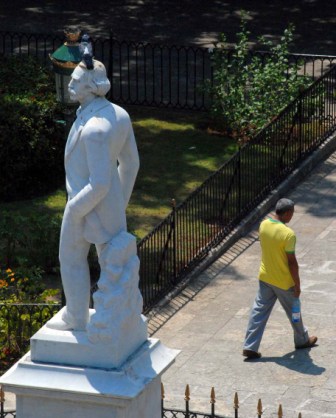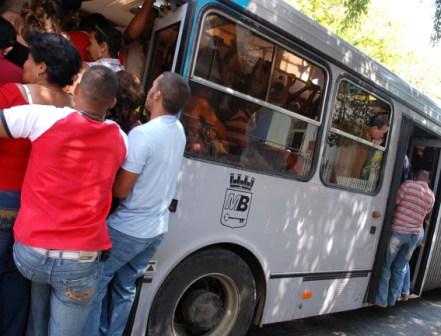Verbal Violence in Havana

HAVANA TIMES, August 13 (IPS) – In times of crisis, problems surface. A few days ago, after a long day at an important Havana cultural institution where I had conducted some negotiations – that were left unresolved – and I had to run to catch a packed bus.
As is unavoidable under those conditions, I unwittingly bumped against a middle-aged female passenger, who complained angrily and loudly. I had no idea of what possessed me, but I myself was surprised when I lashed back at her in irritation with my voice at the same decibel level.
So we faced each other down like in a western. Looking squarely into each other’s eyes, neither of us was willing to lower our gaze, nor accept to be the first to shut up. Meanwhile, the passengers closest to us, almost inexplicably, backed away to give us space for them to better enjoy the view of what seemed a pending fight.
Though no melee occurred, I admit that I felt embarrassed when getting off the bus a few stops later. I wondered how it was possible that neither my academic training, my artistic sensibility nor my Christian convictions had been able to break that temporary display of violence, though it was simply verbal and gestural.
A Trend that Worsens
There are a lot of explanations: I was irritated because the negotiations from which I was coming remained unsolved; I was tired; it was hot, and the jam-packed bus didn’t exactly invite polite behavior. Notwithstanding, I had dispensed with all of my habitual behavioral patterns and joined into – though only for an instant – a current of violence that has taken deep roots in peoples’ behavior for quite some time. My concern is that this is a trend shows no sign of being stemmed, much less eliminated.
From that day on, I have frequently thought back to an address on the issue delivered by Reynaldo Gonzalez at last year’s congress of the National Union of Writers and Artists of Cuba (UNEAC). In it, he said, “I worry a great deal about verbal violence, which spans from the indecent in what is said and the form in which one says it, to the imposition of shouting, which is a form of violence that engenders even more violence.”
Gonzalez, who is the author of El bello habano and a National Literature Prize winner, insisted on the danger of these attitudes when they are manifested in the street, on public transportation, in recreation centers and elsewhere. This aggressiveness is breathed, and it explodes. It is an aggressiveness that is sown in both the individual and the collective psyche.
I worry about this but have no idea as to what we can do to confine it. I know that it depends on the schools; I know that it depends on the mass media; I know that it depends on recreational settings.
If somebody attempts to talk seriously about something, and the other person in the conversation finds it necessary to shout to impose their opinion, the discussion often escalates into yelling. However, you cannot dialogue with yelling – no one understands anything. It is said the origin of war is intolerance, but intolerance is also found in conversation.
Here there is a nuanced vision, which breaks the customary link between violence and physical aggression. For a long time, various institutions have developed programs to assist in problems related to “gender” violence and child abuse. The average citizen knows that fights or attacks on people or groups are interrupted, almost immediately, by the police. However, there are other forms of violence; and while perhaps these are not strictly subject to judicial sanctions, they have become enthroned in the urban panorama.
Recently, a European artist asserted in an interview that Havana is one of the noisiest cities he had ever visited. Clearly he wasn’t referring to the byproducts of mass urban traffic or vibrations caused by heavy industry; he was referring to people’s home music systems. Against every law of coexistence, these attack the ears in every neighborhood. This form of popular communication transcends that intermediate zone between speaking and screaming.
Everything is screamed and argued about in the middle of the street, without caring about the volume of one’s voice, the vocabulary used, or the gestures that accompanies them. The basis of all of this seems to be the belief that if you shout more, you can impose your point of view.
This environmental violence has reached the point of being seen, to a certain degree, as normal, and for some people it is even viewed as an inherent aspect of being Cuban. Practices that were until recently considered marginal are today claimed by some to be a part of our essence, such as in the case of certain reggaeton lyrics.

I am not one of those who condemn this musical genre now in style, because I know too much about our music’s history and the controversies that accompanied the ascent of each genre: danzón, son, or salon rumba, not to mention those that borrowed from other countries, such as the diverse varieties of rock.
Notwithstanding, I have had more than enough experience of having gotten into one of those old 1950s Cuban collective taxis, popularly referred to as “almendrones” (literally “big almonds,” relating to the shape of cars of that era), that go scurrying about the city blasting reggaeton tunes.
These songs – employing the rawest slang – rather than making allusions, blare into the ears of everyone the most violent notions of sex, marked by a macho attitude in which women are much less than objects, with music that is mixed with the deification of certain consumer goods whose possession indicate a supposedly exceptional status in society.
During a 15 minute trip, my son listened to, and even learned, a complete refutation of what I have tried to transmit to him over the years. It was enough to see that something wasn’t right, despite the fact that in Cuban music there has always been picaresque elements in its lyrics.
It goes without saying that it didn’t occur to me to ask the taxi driver to turn off or turn down the music; his appearance and mannerism appeared extracted from a reggaeton of the worst type, and any attempt at dialogue would not only have resulted in failure, but would also have risked me and my family being kicked out of the taxi halfway along the route.
Owners More Violent than their Dogs
Unfortunately this is not an isolated case; many people speak of this kind of violence that circulates in the public light. For most people in Havana it is natural, for example, to see dogs in the streets raised and trained to fight. Although the fact is often criticized, these animals are trained to attack anything that moves in their surroundings – a circumstance with which my own wife and I have had more than one bad experience.
What many do not notice is that behind those animals are owners who are even more violent and abhorrent than the attack dogs.
How do you limit these displays so completely engrossed in the violence that is present in so many homes, and from which aggression is transmitted to schools, working places and public settings?
Many people have expressed that this must be dealt with through education, but it should not be forgotten that education is not the same as culture, and that some people with a certain level of instruction can act even more violently than others with fewer letters but possessing greater spirituality.
Where To Begin
In this understanding and addressing this phenomenon, sociologists and psychologists must contribute points of view based on and extending across all of Cuban society. It is not enough to point to difficult economic conditions, the problems of housing and transportation, or even the tropical heat – though all of these burden the Cuban population to a great degree and are undeniably exasperating factors.
It is necessary to go deeper and tackle the combination of two attitudes: a kind of individualistic pragmatism, whereby many seek to survive based on daily “struggles,” and a marginalization of behavior that is exhibited in a defiant way and in stark opposition to the most elementary norms of social respect.
Confronted with those realities, on more than one occasion the country’s cultural authorities have called for improvement of mechanisms designed to permeate people’s conscience with art and literature. While this is a worthy initiative, I don’t believe that such action is sufficient.
No CD by Frank Fernandez or Ars Longa, no novel by Jose Saramago or Arturo Arango, no fashion exhibition of Arte Moda can in themselves transform such hostility. It is necessary to touch the bare fibers of the spirituality of an entire people, and that is much broader and deeper than the field of aesthetic education.
As I’m writing these lines I’m listening to an the announcement of the upcoming visit to Havana of the Royal Ballet and the possible setting up of a giant screen in front of the Capitol Building for those unable to obtain a seat at the Garcia Lorca Theater. That’s fine.
The most interesting aspect of this outside event may well be the viewing of two spectacles in juxtaposition: on the one hand will be the projected image of dancers Carlos Acosta and Tamara Rojo on the enormous white screen, attacking the technical complexities of the pas de deux of The Corsair with virtuosity.
On the other, we will find the contrast of the area’s regulars, with their inevitable cans of Buccaneer beer in hand, continuing to speak loudly, threatening certain women or performing a different kind of ballet which they use to slip away from the police while never abandoning their territory.
A Havana Times translation of the original article published in Spanish by IPS.






For the past thirty years or so, we have seen a gradual degradation in the people’s behavior, in which, yelling, cursing, not saying good morning, thanks, please, excuse me or sorry, have become extinguished species in our vocabulary and nothing is being done about, except tolerated or celebrated by many. No society can survive without ordinance, regulations and authority. Our local officials are no where to be seen,they do not function, there is no where to complain and worst, the media and its powerful reach, continue oblivious of these crucial issues, until it is too late. None of this is more complex or difficult than other measures the Cuban government have implemented in the past. Limiting smoking in many areas, demanding everyone except the police to bear arms and others, are far more complex and they were successfully applied. Let’s impose discipline, demand respect, sanction violators, if we are to have the educated, cultured society so much have been invested in.